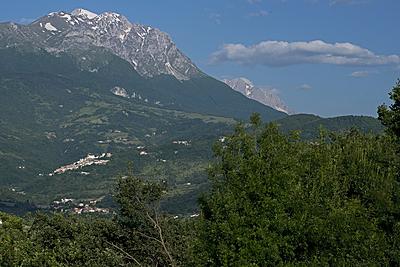



SUGGESTIONS
Gran Sasso D’Italia With its nature reserves and high plateaux, the Gran Sasso is one of the best-known parts of Abruzzo. Its pristine nature has an almost magnetic power of attraction, which will become clear when you discover animals in the wild in the Angri Valley or the wildlife park inhabited by chamois, while hiking in the Voltigno Park or admiring the spectacular waters of the Cascata del Vitello d’Oro.
Abbeys The southeast part of the area is the setting for an itinerary leading to abbeys of great interest, such as S. Clemente at Castiglione a Casauria, S. Maria Casanova at Villa Celiera, S. Bartolomeo at Carpineto della Nora and the Benedictine churches of S. Maria di Cartignano at Bussi sul Tirino and S. Maria delle Grazie at Civitaquana.
Moscatello di Castiglione a Casauria vine This is probably the oldest grape variety in Abruzzo, recorded ever since the 17th century. This white grape has long been cultivated on a strip of land on the Pescara side of the Maiella massif, yielding a wine that is sweet yet never cloying, with scents of mountains flowers and herbs, crisp and very pleasurable thanks to the traces of acidity ensured by the climate.
Pecorino di Farindola This cheese is unique, being made of raw sheep’s milk and pig’s rennet in the eastern foothills of the Gran Sasso, where fragrant breezes blow from the Adriatic. Its flavour and aroma come from the uncontaminated countryside, where it is made completely by hand, a skill that is exclusively female.
Arrosticini or Rustelle With fat and lean meat perfectly balanced, roasted over a special wood charcoal grill, these simple pastoral kebabs are much appreciated and the undisputed king of street foods. Made from slices of mutton, castrato and sheep’s liver alternating with slices of onion, they began to spread in the late 1950s and 60s on the Pescara sides of the Gran Sasso, at Farindola, Villa Celiera, Carpineto della Nora, Montebello di Bertona and Civitella Casanova.
FOOD & PLACES
Terre dei Vestini The area known as Terre dei Vestini comprises fourteen municipalities of the Pescara area. Ten of them lie on the slopes of the Gran Sasso d’Italia and its National Park.
Historic centre of Penne The old town fully repays the steep climb up through ancient alleys. A visit reveals the many historic buildings, the cathedral, the cloister of San Domenico, an archaeological museum, a museum of modern and contemporary art and the churches.
Regional Nature Reserve of Lago di Penne The damming of the Tavo River at its confluence with the Gallero in the sixties gave rise to the Lago di Penne, a WWF natural oasis since 1987 and the gateway to the Gran Sasso National Park. The reserve is home to night-herons, wildcats, badgers, polecats, wolves and other wildlife.
Vestini cheese Fresh and delicate curds, giuncata and primo sale made from the milk of cows pastured on the Voltigno; fresh or semi-cured caciotta; pecorino made from pure sheep’s milk, waxed at three months, ripe at six. All this and the excellence of Pecorino di Farindola, made from raw ewe’s milk and pig’s rennet.
Trout and shrimps Trout and freshwater shrimps from the clear, sparkling spring waters of the Tirino are a revelation between Bussi and Popoli. The noble crustacean is found all year round and enhances the river cuisine in a chowder (guazzetto alla fiumarola), with pasta (chitarra al sugo di gamberi) and in a fish soup (brodetto d’acqua dolce) together with trout, shrimps and eel.
Carpinetana Extra virgin olive oil from Carpinetana olives is moderately fruity with notes of green almonds. This is the identity of the historical variety, with its homeland at the foot of the Gran Sasso at over 400 metres above sea level. A legacy of history, traditions and agricultural
practices enrich the broad DOP olive-growing area of Aprutino Pescarese.
Farro dell’Oasi Emmer wheat is the main product of the Masseria dell’Oasi, set in the midst of the Lago di Penne Nature Reserve. Based on the recovery of local ecotypes of emmer wheat as well as traditional wheat and barley, grown with organic methods and a short supply chain, the Collina Ritrovata at Collalto (near Penne) is a model project in the circuit of European protected areas.
Tomato purée The pomodoro a pera vestino is a variety native to the Pescara area. It is made into sauce, as in every corner of the province. Bottled tomatoes are much more than a tradition here: cooked, raw, chopped or puréed they are a veritable family ritual in Abruzzo.
Gran Sasso honey Wildflower honey, summer savoury, sainfoin, acacia, dandelion and chestnut honey. The Gran Sasso is a bouquet of scents, pure and uncontaminated as the land. The honey is raw, not subjected to any heat treatment, hence it may be fluid, dense or crystallised, depending on the flowers it was gathered from.
Book your holiday
Weather forecast
Traveller information
Contact us »
+39.085.8561222
info@terrepescaresi.it
Our travel offers
Exclusive experiences

Gran Sasso d'Italia
Follow us!
